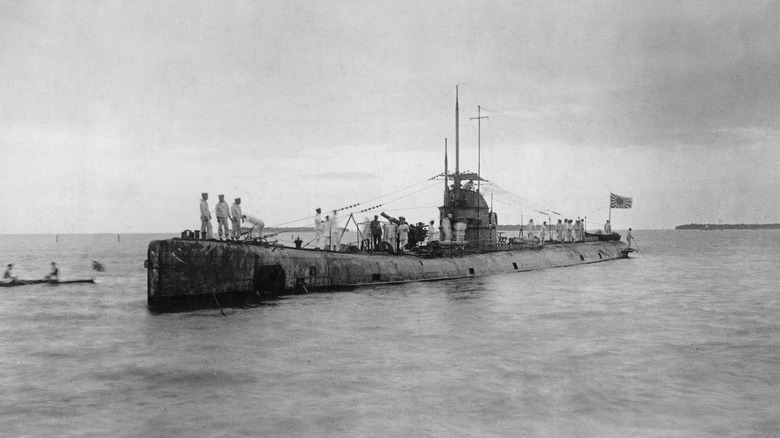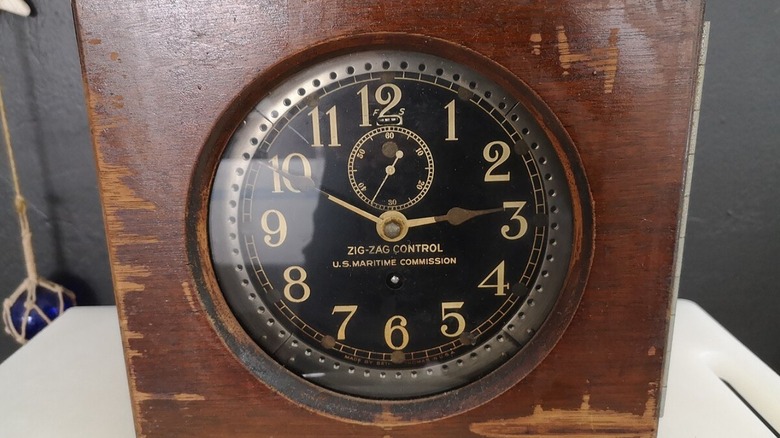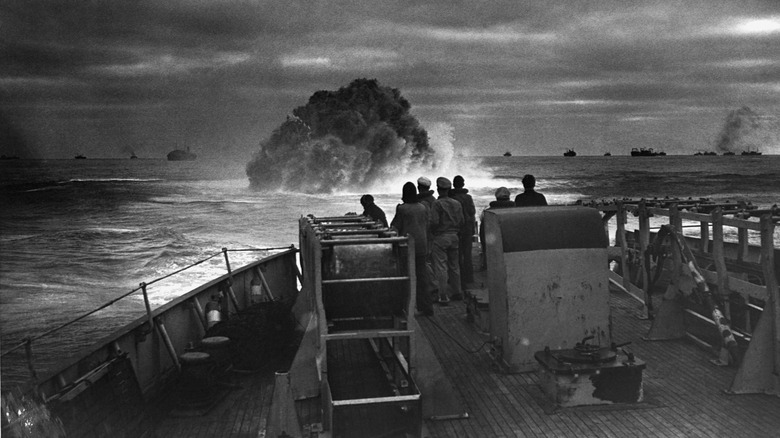Why Navy Ships Zig-Zagged To Avoid Submarines In WW2
Some truly legendary submarines saw combat in World War II, with Germany's formidable U-boats being some of the best known. Naval travel was essential to opposing nations in order to transport weapons, soldiers, and essential supplies, as well as some vessels being war machines in their own right. Accordingly, efforts to develop submarine threats continued apace, as did corresponding efforts to counter them.
The unpredictable and insidious nature of submarines prompted navies to attempt rather experimental approaches to counter them. Some surface ships could go on the offensive with anti-submarine armaments like depth charges, but there were other methods for evading torpedo attacks. Some navy vessels Zig-zagged, following a snaking, changeable course to the destination rather than a straight, predictable one. Battleship New Jersey curator Ryan Szimanski explains (via YouTube) that this technique was used often during the World Wars, and that the primary reasons behind it were twofold.
"Changing course relatively frequently will allow you to potentially throw off that submarine's targeting," because torpedoes, up until the closing stages of the war, typically worked on the basis of aiming a shot in a straight line, taking the target's speed and course into account to 'lead' it into the ship in question. Szimanski added, "More importantly, you're trying to throw off the targeting... so that the submarine never gets into a firing position in the first place." Submarines were generally slower than their targets, so it was pertinent to maneuver into just the right spot to fire.
Overcoming the challenges of a zig zagging movement pattern
Convoys were valuable targets for those submarines confident enough to engage them. The conflict with submarines has had a lasting impact on naval warfare. While they were much more formidable propositions than lone vessels, they were also more vulnerable to torpedo fire. This is because, according to Ryan Szimanski of Battleship New Jersey, "...large convoys of ships could cover dozens of square miles, so even if your ship avoids a torpedo, the ship several ships behind you in line might still be hit."
Big convoys could be a dramatic complicating factor when it comes to the zig-zag technique, because it meant a sort of group choreography was needed to keep multiple different ships in line with each other. It was a seemingly impossible task, but commanders found a simple yet ingenious solution to it.
A device known as a zig-zag clock was created to help convoys stay together while zigzagging without being thrown off course or inadvertently threatening each other. The idea was that each member of the convoy had a zig-zag clock, as well as an identical, complex map of the route to be taken, with the two working in tandem. The clock had an adjustable series of metal pieces around its body, which was connected to the ship's bridge. It would alert the crew with a chime when a course correction was needed. Every ship in the convoy set its clocks identically in order to make each course change in unison.
The advantages of following a zig-zag course to avoid submarines
It wasn't easy for ships to avoid dangerous waters where unfriendly submarines prowled. The priority, instead, was to limit time spent there and ensure the ship's movements were unpredictable. This strategy had some clear advantages. An erratic target is more difficult to hit. Moreover, opposing forces sought to determine each other's plans, strategies, and movements wherever possible. Over the course of a full voyage, following a zig-zagging path meant that it would be that much more difficult to plot exactly where zig-zagging craft were going. If a vessel couldn't outrun a pursuing submarine, it could be just as beneficial in the intervening time to rob its speed advantage.
A 1917 Office of Naval Intelligence document titled "Remarks On Submarine Tactics Against Convoys" provides a valuable example of a way that this could be done: "When attacking a ship or convoy zig-zagging, a submarine must take frequent short looks through her periscope, and consequently can make less use of her speed."
For the submarine crew, the incessant need to re-evaluate and reposition could frustrate an attack. A single well-placed torpedo can potentially devastate an enormous vessel, but successfully targeting them in this way, with tricky variables like distance and the ocean's movements, is particularly difficult. Submarines can be deadly threats, and one U.S. submarine was even sunk by its own torpedo, which is why all manner of strategies to use against them were devised.


